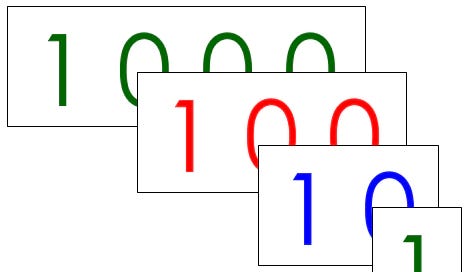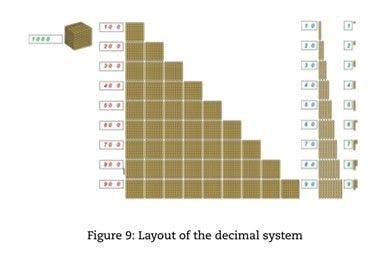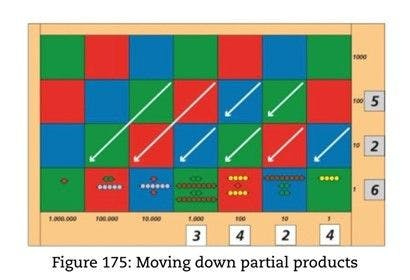

Discover more from Higher Ground's Friday Notes
Place value as soulcraft
Happy Friday.
The Montessori curriculum is unreasonably effective. The materials not only allow children to learn more earlier, and not only allow children to learn more effectively, but they also allow children to learn more deeply—to acquire knowledge in a way that allows for the formation of deep character traits.
Take place value. Our everyday representation of numbers assigns them with different significance, depending on the length of the representation and the order in which the number is placed. Each “1” in “111” means something different. Place value is complex. It’s a form of compression that itself relies on iterated multiplication. The relative position of a number determines its order of magnitude.
Interestingly, in Montessori math, the target of mastery is decimal place value. The whole Montessori math curriculum is geared towards developing a cognitive, habitual, almost physical understanding that going past 9 means that something changes.
From 1 to 9 you are piling things. But add one more and you get something new, a new form, a new unity, and a new “one”.
In the words of Montessori,
The key to the decimal system lies in the final play between nine and ten. This is the key that opens the door to the organization of the various groups of units into a highly interesting systematic framework. Indeed, exceeding nine by only one, there are no digits to represent the new group that is formed: one has to go back to the beginning again… (Psychoarithmetic)
Consider how you interact with Montessori’s Golden Beads:
Pile single beads until you get to ten, then replace them with one ten bar. The ten bar is a new thing. It’s composed of ten individual beads, but they are wired together into a new unity, a line.
Or, pile ten bars until you get to ten tens, and then swap them for a hundred square.
Or, ten hundred squares get swapped for a thousand cube.
Then the whole thing recurses: ten thousands cubes become a line, a ten thousand bar. Then ten thousand bars become a hundred thousand square, and ten of those squares become a million cube.
This is true not just of the golden beads (pictured above) and associated work, but, in different ways of every arithmetic Montessori material, including the classic sensorial materials (pink tower, red rods, etc.). They are organized around tens.
When children learn column addition and multiplication, they understand why it works, because they understand—because it’s been part of their physical environment and activity since they were 2—what place value is. This understanding enables further work, such as the checkerboard, that simultaneously builds upon and reinforces this understanding of the meaning of place value.
Why does any of this matter?
First, it matters for cognitive independence. Is your mind made of routines that are alien incantations that you mysteriously “work”? Or is it understood, made up of independently cognized algorithms, which you can mull and interrelate, and in which you have earned confidence?
Naturally what the child is offered is certainly not a toy but an exact material for study, capable of helping him to overcome all the difficulties that are encountered by children in the regular school, where they are taught to count and calculate based on the decimal system without being proffered any explanation of the principles on which that system is founded. (Psychoarithmetic, emphasis added)
Second, it matters for math—for if and when you hit a wall in your learning. The more math concepts you really understand, the better a foundation you have for advancing.
Third, it matters for your relationship with the world, a world that is increasingly mathematical. Even if your life’s work isn’t particularly mathematical, being alienated from math means being alienated from progress. Montessori writes of the increasing importance of math, in a passage that could have been written today:
Mathematics are necessary because intelligence today is no longer natural but mathematical, and without developing an education in mathematics it is impossible to understand or take any part in the special forms of progress characteristic of our times period a person without mathematical training today is like in illiterate in the times when everything depended on literary culture. But even in the natural state human mind has a mathematical bent, tending to be exact, to take measurements and make comparisons, and to use its limited powers to discover the nature of the various “effects” that nature presents to man while she conceals from him the world of causes. Because of this vital importance of mathematics, the school must use special methods for teaching it, and make clear and comprehensible its elements with the help of plenty of apparatus that demonstrates the “materialized abstractions” of mathematics. (From Childhood to Adolescence)
Last but not least, it matters for your soul.
Math is the realm of precision, exactitude, quantity, measurement, and logic. If that’s the realm you’ve populated with secondhand incantations, that will invariably transfer to areas of life in which those things are cognate. (Which is every area.) The exactitude of the mind, the quality of judgment of the mind, and the independence of the mind are interrelated. Montessori again:
When you say “There goes a man of vague mentality. He is clever but indefinite,” you're hinting at a mind with plenty of ideas, but lacking in the clarity which comes from order period of another you might say, “He has a mind like a map. His judgments will be sound” in our work, therefore, we have given a name to this part of the mind, which is built up with exactitude, and we call it “the mathematical mind.”
I take the term from Pascal, the French philosopher, physicist and mathematician, who said that man's mind was mathematical by nature and that knowledge and progress came from accurate observation. (The Absorbent Mind)
This is why Montessori’s main works on math are called Psychoarithmetic and Psychogeometry. It’s math—learned in a way so that it has a deep, positive impact on your psyche.
Place value, early and materialized in a dozen ways, is an important component of a great education. And it’s a model for how learning should work: the foundations of knowledge are built so well that it is coextensive with soulcraft.
Have a great weekend,
Matt Bateman
Executive Director, Montessorium
Subscribe to Higher Ground's Friday Notes
Broadcasting the weekly internal memos of Higher Ground Education






